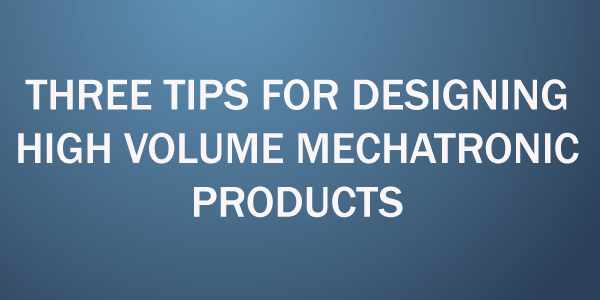As I discussed in part one of my three-part mechatronics discussion, there are many, many types of mechatronics systems in the world. In industry, the largest market segment that would clearly identify itself as a mechatronic sector is industrial automation. There’s a rich base of suppliers of industrial automation components such as servo motors, motor drives and industrial controllers. In addition, there are many system integration companies that can take these components and build amazing machines. America’s production lines run on the work that these companies do.
While the industrial automation industry does make amazing machines, these machines are usually one-off designs, or at most are replicated a handful of times. That means that the overall machine cost structure of the design plus fabrication costs do not support a high level of design optimization. In that type of design, using high quality, and expensive, components make sense. However, if you are building in moderate to high volume, part cost adds up quickly. In high volume designs, the design NRE (non-recurring engineering cost) is often greatly outweighed by the component cost multiplied by the volume, the total cost of production over the production life. It’s absolutely critical that you understand the trade-off between design NRE and BOM cost in high volume designs.
If you’re designing a high volume product that has a mechatronic component, the design NRE should be focused on delivering the largest BOM cost reductions possible. Based on over a decade of building motion control systems for the high volume HP ink jet printer product lines, here are three things that will have the biggest impact on improving the quality of your solution:
- Use of manufacturing technologies and components that are cost competitive in high volume. Custom components for drive trains are most often fabricated from sheet metal and injection molded plastic. Sensors and microprocessors should leverage technologies that are in use in high volume consumer product such as cell phones. And for motion, I recommend using low-cost brushed DC motors where possible. Note that brushed DC motors often provide a higher performance/cost ratio than stepper motors, even when you include the cost of a feedback element.
- Balance the design margin across the mechatronic system. Companies often fall into the trap of treating the mechatronic system as a bunch of unrelated systems each owned by their traditional engineering discipline. If you don’t have a mechatronics design owner that understands the electrical, mechanical and software/firmware design, you’re probably putting too much cost into the system. The power supply, drive electronics, motors and mechanics should all be designed as a single system so that design margin is balanced across the components. All of these components should have approximately the same design margin. Excess margin in any component is excess cost.
- Finally, look for opportunities to downsize components by using clever algorithms. I call this “trading atoms for bits”. Your manufacturer will charge you for every “atom” (i.e. material) that goes into the product, but “bits” are essentially free to reproduce. The opportunities for this type of cost saving come from a deep understanding of your customer’s needs, and how your machine operates. The trade-offs involved may be difficult to make, but can provide real competitive cost advantages.
Focusing your design efforts in these three areas will help you drive your mechatronic design to the optimal cost versus performance tradeoff for your system. Good luck with your next design!

